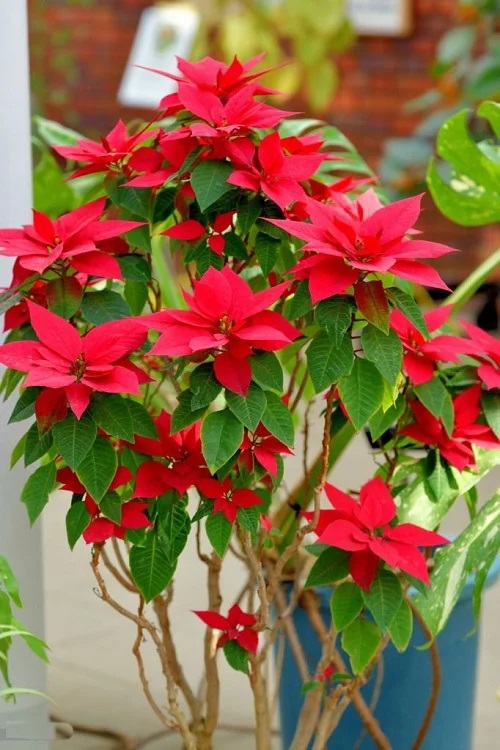Find How to Keep Your Poinsettia Plant Red for a Long Time with some out-of-the-box tips and tricks!

With their vibrant red leaves, these plants are more than just a festive holiday decoration – they can be a gardening project where you can experiment with their leaves (bracts)!
Learn How to Get a Poinsettia to Turn Red in this Post
The Science Behind Red Leaves of Poinsettia
Poinsettias, widely recognized for their vibrant red bracts, undergo a fascinating color transformation that aligns with the festive Christmas season. This shift in hue is primarily due to two factors: photoperiodism and the presence of specific pigments known as anthocyanins.
1. Photoperiodism
Poinsettias are classified as “short-day plants,” which means they initiate their color change when the days become shorter. As we move into fall and winter, the decreasing daylight and extended night periods serve as a natural cue for these plants.
This seasonal timing explains why poinsettias are famously red during the winter holidays.
2. Anthocyanins
These pigments, common in various red, purple, and blue plants, are produced more abundantly under specific light conditions. In poinsettias, when exposed to shorter days and longer nights, the surge in anthocyanin production results in their iconic red bracts.
Moreover, a plant pigment called phytochrome plays a significant role in this color transition. It functions as a light sensor, detecting changes in the duration of light exposure.
When the poinsettia perceives longer periods of darkness, phytochrome triggers a chain of biochemical reactions. These reactions lead to increased anthocyanin production, ultimately causing the bracts to turn red.
Find How to Rebloom Poinsettias in this Guide
The Number 1 Trick to Make and Keep Your Poinsettia Plant Red

To achieve the iconic red bracts of poinsettias, a specific routine of light and darkness is essential.
1. Embracing the Dark
- How Long? Your poinsettia needs around 14 hours of complete darkness each night. This should continue for about 8 to 10 weeks.
Pro Tip: You can also experiment with extending this period slightly. An additional week or two of extended darkness may intensify the bract color.
- When to Start? Kick-off this routine any time in the fall. Aim to give your plant its dark ‘night’ from around 5 in the evening to 8 in the morning.
Pro Tip: You can initiate the extended darkness routine earlier in the year, typically in late summer or early to mid-August, to provide more time for the bracts to develop and intensify their color. Starting early allows you to have a more extended period of controlled darkness.
2. Welcoming the Light
- Daytime Sunlight: Allow your poinsettia to bask in bright but indirect sunlight for 6 to 8 hours during the day. It won’t mind a bit of direct morning sunlight (2-3 hours), too.
- The Right Light: Make sure it’s getting indirect light. Direct sunlight might be too intense for your plant.
3. Keeping Up the Routine
- Stay on Schedule: It’s crucial to maintain this pattern without interruptions. Unexpected light during the supposed ‘dark period’ can hinder color development.
- Creating Darkness: Can’t find a naturally dark spot? Cover your plant with something like a black cloth or place it in an unlit closet to ensure it gets the darkness it needs.
Other Tips and Tricks to Keep Your Poinsettia Plant Red for a Long Time
1. Temperature Fluctuations
Maintain a 10°F difference between day and night temperatures. Cooler nights help retain the red pigment in leaves. Aim for 65-70°F in the daytime and around 55-60°F at night.
Explore Ideas to Decorate your Home with Poinsettias in this Post
2. Selective Pruning and Pinching
Prune the poinsettia in late spring or early summer to encourage bushier growth and more color. Pinch back the tips of new growth to stimulate branching.
This results in a fuller and more vibrant display of red bracts.
3. Use Coffee Grounds in the Potting Mix
Add used coffee grounds to the soil – a teaspoon per pot will suffice for a month. The slight acidity helps enhance nutrient uptake, aiding in color maintenance.
4. Use Eggshell Tea
For a natural fertilizer, use crushed eggshells steeped in water. This eggshell tea provides calcium, promoting leaf health and color retention.
Mix its solution with water in a 1:1 ratio and water the plant with it once in 2-3 weeks.
Check the Types of Poinsettias You Can Grow Indoors here
5. Monitor Indoor Humidity
Indoor environments, especially during winter, can be quite dry. Consider using a humidity monitor and adjusting the humidity levels to mimic its native tropical conditions.
Use a pebble tray with water or mist the area around the poinsettia. You can also go for a humidifier. This prevents the leaves from drying or dropping and losing color.
6. Keeping the Growing Medium Slightly Moist
Moist soil ensures that the leaves are well-hydrated, which greatly prevents their chances of getting dry and brittle – leading them to fall off the plant.
Drying out of the growing medium can stress the plant – a common trigger for leaf drop in many plant species. So, ensure you are never letting the soil dry out completely.
7. Rotate the Plant
Rotate your poinsettia periodically to ensure that all sides receive equal light. This helps in even growth and coloring of the bracts.
8. Go for the Right Poinsettia Varieties
Go for varieties that naturally produce a more vibrant red hue. The best ones are:
- Prestige Red: Known for its bright, deep red color, it is a popular choice for its strong and long-lasting bracts.
- Freedom Red: This variety is celebrated for its large, bold red bracts and dark green foliage, creating a striking contrast.
- Cortez Red: Cortez Red stands out for its large, intensely red bracts and exceptional durability, making it a favorite for holiday displays.
- Luv U Pink (Red Variant): While primarily known for pink bracts, this variety produces a stunning red variant with vibrant, heart-shaped bracts.



